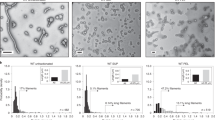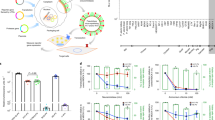Abstract
SUSCEPTIBILITY of rodent cells to infection by ecotropic murine leukaemia viruses (MuLV) is determined by binding of the virus envelope to a membrane receptor that has multiple membrane-spanning domains1. Cells infected by ecotropic MuLV synthesize envelope protein, gp70, which binds to this receptor, thereby preventing additional infections. The consequences of envelope-MuLV receptor binding for the infected host cell have not been directly determined, partly because the cellular function of the MuLV receptor protein is unknown. Here we report a coincidence in the positions of the first eight putative membrane-spanning domains found in the virus receptor1 and in two related proteins2, the arginine2–4 and histidine2,3,5 permeases of Saccharomyces cerevisiae (Fig. 1), but not in any other proteins identified by computer-based sequence comparison of the Gen Bank data base1. Xenopus oocytes injected with receptor-encoding messenger RNA show increased uptake of L-arginine, L-lysine and L-ornithine. The transport properties and the expression pattern of the virus receptor behave in ways previously attributed to y+ (refs 6, 7), the principal transporter of cationic L-amino acids in mammalian cells.
This is a preview of subscription content, access via your institution
Access options
Subscribe to this journal
Receive 51 print issues and online access
$199.00 per year
only $3.90 per issue
Buy this article
- Purchase on Springer Link
- Instant access to full article PDF
Prices may be subject to local taxes which are calculated during checkout
Similar content being viewed by others
References
Albritton, L. M., Tseng, L., Scadden, D. & Cunningham, J. M. Cell 57, 659–666 (1989).
Weber, E., Chevalier, M. R. & Jund, R. J. molec. Evol. 27, 342–350 (1988).
Cooper, T. G. in The Molecular Biology of the Yeast Saccharomyces: Metabolism and Gene Expression (eds Strathern, J., Jones, E. & Broach, J. R.) 399–461 (Cold Spring Harbor Laboratory, New York, 1982).
Hoffmann, W. J. biol. Chem. 21, 11831–11837 (1985).
Tanaka, J. & Fink, G. R. Gene 38, 205–214 (1985).
White, M. F., Gazzola, G. C. & Christensen, H. N. J. biol. Chem. 257, 4443–4449 (1982).
White, M. F. Biochim. biophys. Acta 822, 355–374 (1985).
Melton, D. A. et al. Nucleic Acids Res. 12, 7035–7057 (1984).
White, M. F. & Christensen, H. N. J. biol. Chem. 257, 4450–4457 (1982).
Birnbaum, M. S. Cell 57, 305–315 (1989).
Rosenberg, L. E., Downing, S. J. & Segal, S. J. biol. Chem. 237, 2265–2271 (1962).
Segal, S., McNamara, P. D. & Pepe, C. M. Science 197, 169–171 (1977).
Vadgama, J. V., Castro, M. & Christensen, H. N. J. biol. Chem. 262, 13273–13284 (1987).
Van Winkle, L. J. Biochim. biophys. Acta 947, 173–208 (1988).
Pardridge, W. M. & Jefferson, L. S. Am. J. Physiol. 228, 1155–1161 (1975).
Oxender, D. L. & Christensen, H. N. J. biol. Chem. 238, 3686–3699 (1963).
Christensen, H. N., Liang, M. & Archer, E. G. J. biol. Chem. 238, 3686–3699 (1967).
Kilberg, M. S., Handlogten, M. E. & Christensen, H. N. J. biol. Chem. 255, 4011–4019 (1980).
Shotwell, M. A., Kilberg, M. S. & Oxender, D. L. Biochim. biophys. Acta 737, 267–284 (1983).
White, M. F. & Christensen, H. N. J. biol. Chem. 258, 8028–8038 (1983).
Jaenisch, R. Cell 19, 181–186 (1980).
Hatzoglou, M. et al. J. biol. Chem. 265, 17285–17293 (1990).
Segal, S., McNamara, P. D. & Pepe, C. N. Science 197, 169–171 (1977).
Samarzija, I. & Fromter, E. Pflugers Arch. 393, 199–205 (1982).
Desjeux, J. F., Volanthen, M., Dumontier, A. M., Simell, O. & Legrain, M. Pediat. Res. 21, 477–482 (1987).
Aronson, D. L. & Diwan, J. J. Biochemistry 20, 7064–7070 (1981).
Mueckler, M. et al. Science 229, 941–945 (1985).
Hediger, M. A., Coady, M. J., Iheda, T. S. & Wright, E. M. Nature 330, 379–381 (1987).
Smith, R. F. & Smith, T. F. Proc. natn. Acad. Sci. U.S.A. 87, 118–122 (1990).
MacLeod, C. L., Finley, K., Kakuda, D., Kozak, C. A. & Wilkinson, M. F. Molec. cell. Biol. 10, 3663–3674 (1990).
Author information
Authors and Affiliations
Rights and permissions
About this article
Cite this article
Kim, J., Closs, E., Albritton, L. et al. Transport of cationic amino acids by the mouse ecotropic retrovirus receptor. Nature 352, 725–728 (1991). https://doi.org/10.1038/352725a0
Received:
Accepted:
Issue Date:
DOI: https://doi.org/10.1038/352725a0
This article is cited by
-
Structural basis of hepatitis B virus receptor binding
Nature Structural & Molecular Biology (2024)
-
Screening of commonly prescribed drugs for effects on the CAT1-mediated transport of l-arginine and arginine derivatives
Amino Acids (2022)
-
Cationic amino acid transporters and their modulation by nitric oxide in cardiac muscle cells
Biophysical Reviews (2021)
-
Uptake and metabolism of arginine impact Plasmodium development in the liver
Scientific Reports (2017)
-
The infectious BAC genomic DNA expression library: a high capacity vector system for functional genomics
Scientific Reports (2016)
Comments
By submitting a comment you agree to abide by our Terms and Community Guidelines. If you find something abusive or that does not comply with our terms or guidelines please flag it as inappropriate.



